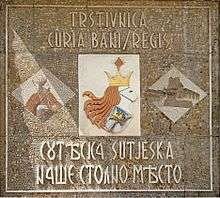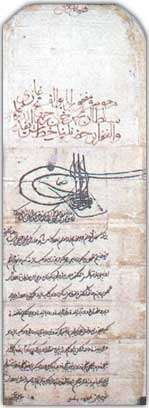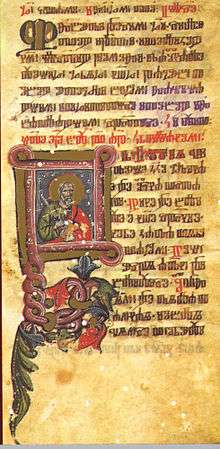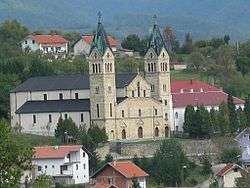Franciscan Province of Bosna Srebrena
Franciscan Province of Bosna Srebrena (also Bosna Argentina; officially Latin: Provincia OFM Exaltationis S. Crucis - Bosna Argentina) is a province of the Franciscan order of the Catholic Church in Bosnia and Herzegovina. Their headquarters are currently in Sarajevo.


Monasteries and locations

The Province of Bosna Srebrena includes the monasteries in:[1]
- Sarajevo / Bistrik – samostan sv. Ante,
- Sarajevo / Kovačići – samostan Uzvišenje sv. Križa i svetište Nikole Tavelića,
- Sarajevo / Nedžarići – samostan sv. Pavla;
- Rest of Bosnia and Herzegovina:
- Visoko – Samostan sv. Bonaventure,
- Franciscan monastery in Kraljeva Sutjeska – Samostan i župa sv. Ivana,
- Franciscan monastery in Fojnica – Samostan i župa Svetoga Duha,
- Guča Gora Monastery – Samostan i župa sv. Franje Asiškog,
- Dubrave – samostan sv. Ante i župa Bezgrešnog Začeća,
- Livno / Gorica – samostan sv. Petra i Pavla,
- Franciscan monastery of Saint Luke, Jajce – Samostan sv. Luke i župa Uznesenja Marijina,
- Olovo – samostan Uznesenja Marijina,
- Franciscan monastery Saint Catharine, Kreševo – samostan sv. Katarine i župa Uznesenja Marijina,
- Petrićevac – samostan Presv. Trojstva i župa sv. Ante Padovanskoga,
- Plehan – samostan i župa sv. Marka,
- Rama / Šćit – samostan i župa Uznesenja Marijina,
- Tolisa – samostan i župa Uznesenja Marijina,
- Tuzla – samostan i župa sv. Petra apostola,
- Samostan sestara Klarisa u Brestovskom;
- Croatia:
- Podsused – samostan sv. Ilije;
- Serbia:
- Beograd – Samostan i župa Sv. Ante Padovanskog;
- Đakovica – Samostan i župa sv. Petra i Pavla.
History
| Part of a series on the |
| Catholic Church in Bosnia and Herzegovina |
|---|
 |
|
History History of the Catholic Church Bosnia and Herzegovina History of Croats in Bosnia and Herzegovina Historical dioceses Diocese of Duvno Diocese of Sarsenterum Diocese of Bosnia |
|
Organisation Episcopal Conference Province of Sarajevo Archdiocese of Vrhbosna Diocese of Banja Luka Diocese of Mostar-Duvno Diocese of Trebinje-Mrkan Other Military Ordinariate Apostolic Nunciature |
|
Clergy Pope Francis Ordinaries Vinko Puljić · Tomo Vukšić · Franjo Komarica · Petar Palić · Ratko Perić · Marko Semren · Pero Sudar · Apostolic Nuncio Luigi Pezzuto |
|
Canonized people bl. Ivan Merz bl. Drina Martyrs |
|
Sacred Heart Cathedral Cathedral of Saint Bonaventure Cathedral of Mary the Mother of the Church Cathedral of the Birth of Mary |
|
Churches and shrines Churches Shrines Shrine of the Queen of Peace Shrine of Our Lady of Olovo Shrine of Saint John the Baptist Shrine of Saint Leopold Mandić |
|
Apparitions in Međugorje |
|
The Franciscans order arrived in Bosnia in the later half of the 13th century, aiming to eradicate the teachings of the Bosnian Church. The first Franciscan vicariate in Bosnia was founded in 1339/40. The province itself is the only institution in Bosnia and Herzegovina which has operated uninterruptedly since the Middle Ages.[2]
The Franciscan order was allowed by Sultan Mehmed II the Conqueror in the Ottoman Empire in 1463, after the Ottoman conquest of Bosnia and Herzegovina. Friar Anđeo Zvizdović of the Monastery in Fojnica received the oath on May 28 of 1463 at the camp of Milodraž.[2][3][4]
The Ahdname of Milodraž stated:
"I, the Sultan Khan the Conqueror, hereby declare the whole world that, the Bosnian Franciscans granted with this sultanate ferman are under my protection. And I command that:
No one shall disturb or give harm to these people and their churches! They shall live in peace in my state. These people who have become emigrants, shall have security and liberty. They may return to their monasteries which are located in the borders of my state. No one from my empire notable, viziers, clerks or my maids will break their honour or give any harm to them!
No one shall insult, put in danger or attack these lives, properties, and churches of these people! Also, what and those these people have brought from their own countries have the same rights...
By declaring this ferman, I swear by a great oath; by the Creator (Allah), Who has created the Heavens and the Earth and Who feeds all of his creatures, by seven of his Holy Books, Allah's Great Prophet Mohammed and 124.000 former prophets, and by my sword that no one from my citizens will react or behave the opposite of this ferman!"
The original edict is still kept in the Franciscan monastery in Fojnica. It is one of the oldest surviving documents on religious freedom. In 1971, the United Nations published a translation of the document in all the official U.N. languages. The ferman was republished by the Ministry of Culture of Turkey for the 700th anniversary of the foundation of the Ottoman State.
Without a regular hierarchy of bishops in place, the diocesan clergy fell into decline and disappeared by the mid-19th century. To support the local church which was functioning without resident bishops, the Holy See founded an Apostolic Vicariate for Bosnia in 1735, and assigned Franciscans as apostolic vicars to direct it. The Franciscan Province of Bosna Srebrena was restructured to correspond to the borders of Ottoman rule in 1757; it split in 1846, when friars from the Kresevo monastery broke off to found the monastery at Siroki Brijeg. A separate Franciscan jurisdiction (a "custody") was established for Herzegovina in 1852. Pope Leo XIII raised it to the status of a province (the Province of the Assumption of the Blessed Virgin Mary) in 1892.[5] [6]
See also
- Franciscan Province of the Assumption of the Blessed Virgin Mary, the other Franciscan province in Bosnia and Herzegovina
References
- "Samostani i župe" (in Croatian and Bosnian). www.bosnasrebrena.ba. Retrieved 30 August 2012.
- "Bosna Srebrena u prošlosti i sadašnjosti | FMC Svjetlo riječi". Svjetlorijeci.ba. Retrieved 2016-08-17.
- "Croatia and Ottoman Empire, Ahdnama, Sultan Mehemt II". Croatianhistory.net. Retrieved 2016-08-17.
- "A Culture of Peaceful Coexistence: The Ottoman Turkish Example; by Prof. Dr. Ekmeleddin IHSANOGLU". Light Millennium. Retrieved 2016-08-17.
- "Catholic Church in Bosnia-Herzegovina" (PDF). Sarajevo: Catholic News Agency, Bishops Conference of Bosnia and Herzegovina. 2002. Archived from the original (PDF) on 2011-09-27. Retrieved 2012-08-30.
- Vjekoslav Perica (2004). Balkan Idols: Religion and Nationalism in Yugoslav States. Oxford University Press. pp. 117–18.
External links
| Croatian Wikisource has original text related to this article: |
- Official website (in Croatian)
